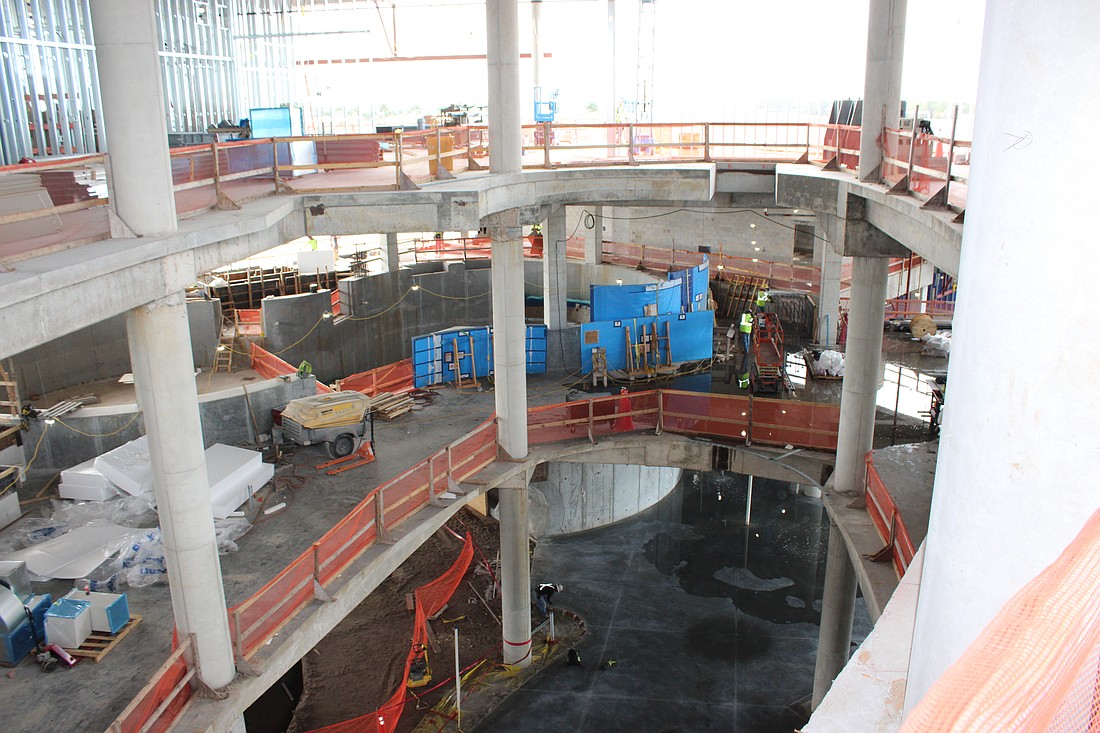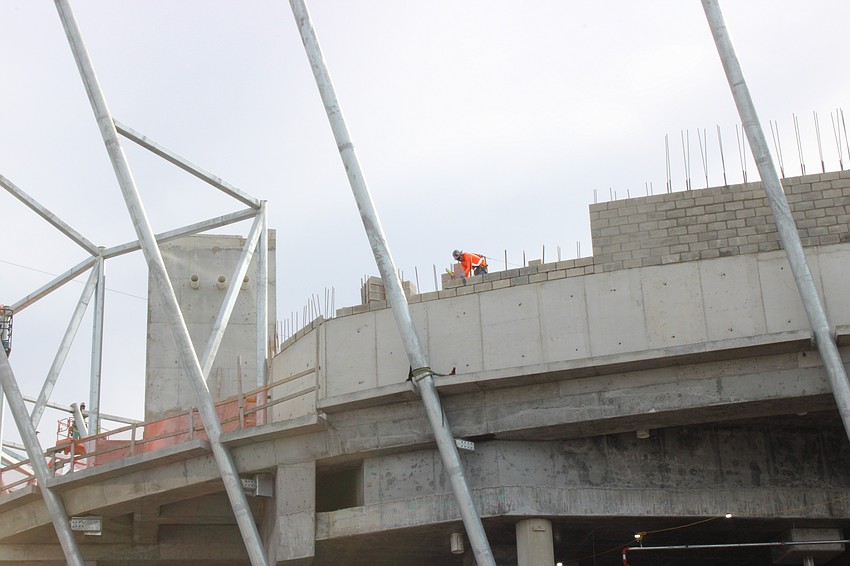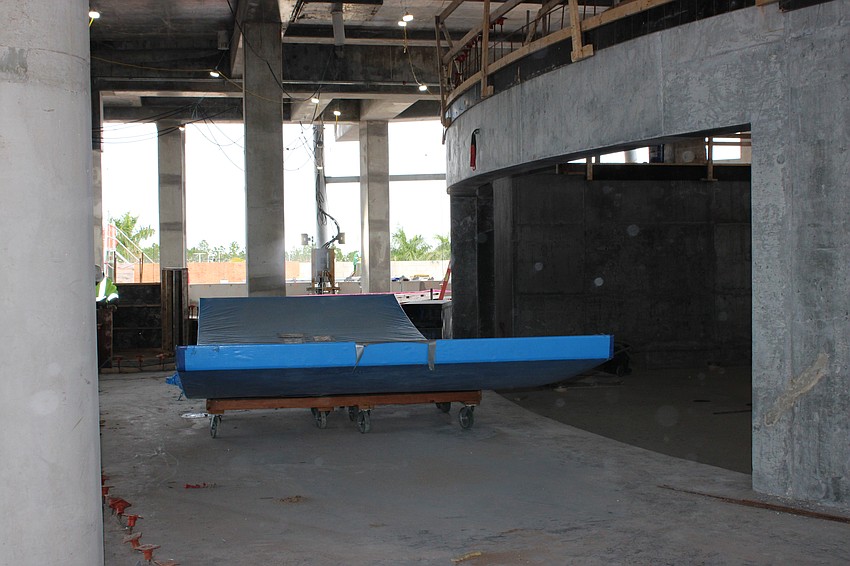- May 8, 2025
-
-
Loading

Loading

In 2024, this ship will be ready to sail.
It will be about Thanksgiving when Willis Smith Construction and Whiting-Turner will declare the $132 million Mote Science Education Aquarium sea-worthy and will turn the facility over to Mote Marine Laboratory & Aquarium executives.
Then, after the certificate of occupancy is delivered by Sarasota County, it will take another three to four months for Mote to acclimate the wildlife to the 1 million gallons of water in the exhibits before the public can get on board. Expect the doors to swing open about February 2025.
By July of 2024, the exterior of Mote's Science Education Aquarium will be sealed so weather is no longer a factor and interior construction can speed forward.
The mostly finished exterior, which has the look of a sleek ship, will be somewhat of a tease to those driving by the facility across from the Mall at University Town Center and adjacent to Nathan Benderson Park in Sarasota.
It's already going to look open for business.
"In the first two quarters, we should have the entire facade complete," said Willis Smith Construction's Brian Saunders, the project manager. "When you drive by, it will look like it what it will look like when it opens to the public."
Those who can't wait for opening day won't be able to see the army of workers finishing the interior.
'"Dry-in means the building is sealed for rain," said Dave Otterness, the Willis Smith project executive for the facility. "A lot of construction can't go forward without dry-in. Then we will have more than 200 workers a day going six days a week."
In the first six to seven months of 2024, more than 4,000 metal panels have to be put into place to create the building's exterior "skin." It's both a functional and artistic design that everyone associated with the project promises will create one of the region's top landmarks.
It will be a fascinating process that is likely to attract new donors.
"We're getting a lot of donors interested now," said Dan Bebak, a vice president at Mote Marine Laboratory and Aquarium. "It is starting to take shape. We are getting foundations and corporations interested in learning more. They are asking questions such as 'Where are you going to get the sea water? How are you going to move all the animals?'"
Bebak said Mote will make most of the sea water on site or will truck it in from its current site. He said moving the animals is not an issue as "we move a lot of animals around all the time and our staff is very skilled" at that task.
But first the exterior must be finished, one panel at a time. It is a fascinating process that Otterness said will create the "ocular" shape of the building.

"There are not a lot of 90-degree corners, and that creates an optical illusion," said Otterness, who lives in Mill Creek. "It is difficult because there is nothing straight, but our vision is to build landmarks. and this is the biggest one we've ever done in our 50-year history."
Saunders, who lives in Parrish, said he likes difficult projects so he loves being associated with this one.
"It is unique architecture," he said. "There is nothing straight and all the columns are at an angle. All the walls are insulated 4-by-6 foot metal panels that go on in segments. We have three-inch pieces of foam with metal panels laminated to it. Typically, when you see these panels, it is done on flat surfaces."
Other metal panels are attached to the primary panels to create designs.
That is just part of the complexity that faces Willis Smith and Whiting Turner this year.
"We have the Inside Life Support System," Saunders said. "We already have 1 mile of LSS pipe in the ground (with 5 miles at completion). Every exhibit has LSS pipe in it."
He said the exhibits have different needs when it comes to each one's Life Support System.
"A manatee's water quality is different than what an otter needs (for example)," he said.
Otterness said the two construction companies are creating a "24/7 facility."
"We are creating a facility that mimics Mother Nature," Otterness said.
The concrete to form all the major exhibits is in place, but the acrylic is not yet in place. Once the acrylic is set, more than 500,000 gallons of water will be used, recycling through the various exhibits, to check the tanks.
"We have to make sure it doesn't leak," Otterness said.
While the interior work will be the major part of the final six months of a project that was announced in February 2018 and broke ground in November 2020, outside the parking lots, sidewalks, walkways and landscaping will be finished.
Furniture will arrive in November, just before Mote begins the process of stocking the aquarium.
"The big thing is to acclimate the fish," Otterness said.
Otterness said a difficult process has been easier now because "we can 3D model everything and cut pieces exactly how they need to be.
"We have been very proactive in our problem solving, getting ahead of it," he said.

Saunders said he is proud to be associated with the project.
"It is a landmark for this area, and even nationally," he said. "There are not a tremendous amount of aquariums of this magnitude.
Bebak said the incredibly difficult project has moved along right on schedule.
"We went through a drought, but that meant we didn't have any bad weather or hurricanes," he said. "We didn't lose any time with that. Things are going smoothly."
Bebak said Mote has raised more than $100 million for the project with the hope of another spike in fundraising now that the project is taking shape.
"We have donors foundations and corporations interested in learning more," he said. "It is easier now for us to get in and show prospective investors."
Personally, Bebak said he is looking forward to seeing the permanent colony of penguins that will occupy an exhibit, and he said he also can't wait to see the giant Pacific octopus.
"We are past a lot of those critical moments," he said. "We have seen the most significant concrete work done. We have miles of plumbing."
Bebak said anyone who is considering a volunteer position or employment with the aquarium can keep going to the website at Mote.org.
He said about 90% of the wildlife at the current facility will move to the Science Education Aquarium.
Bebak said Mote is in contact with regional school districts so a curriculum will be in place when the aquarium opens so they "can hit the ground running."